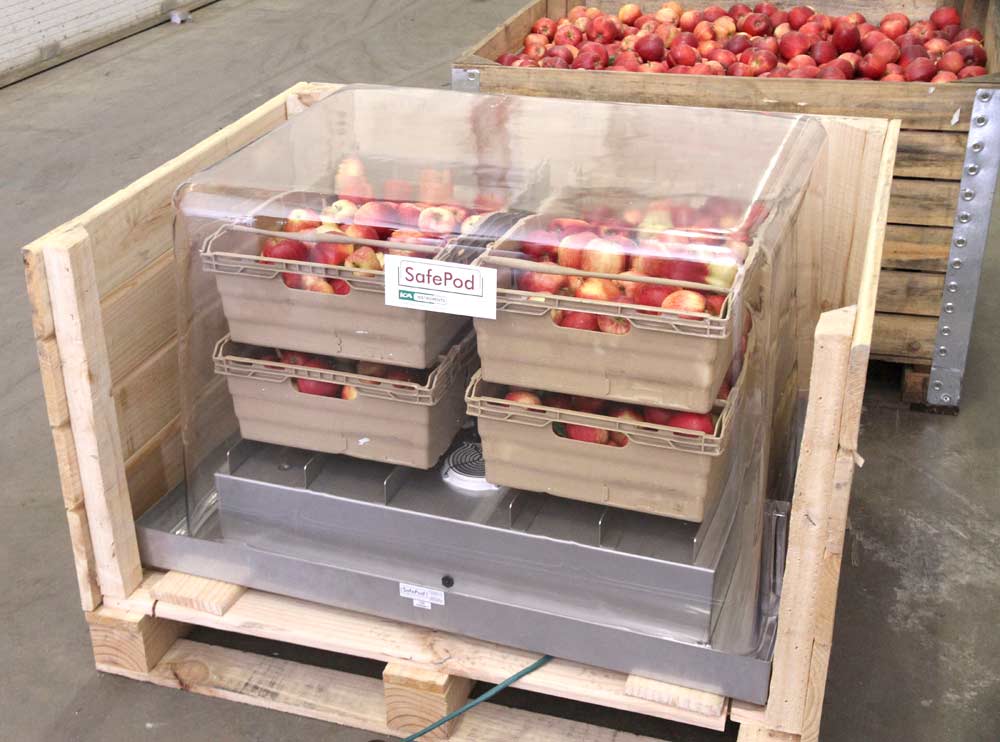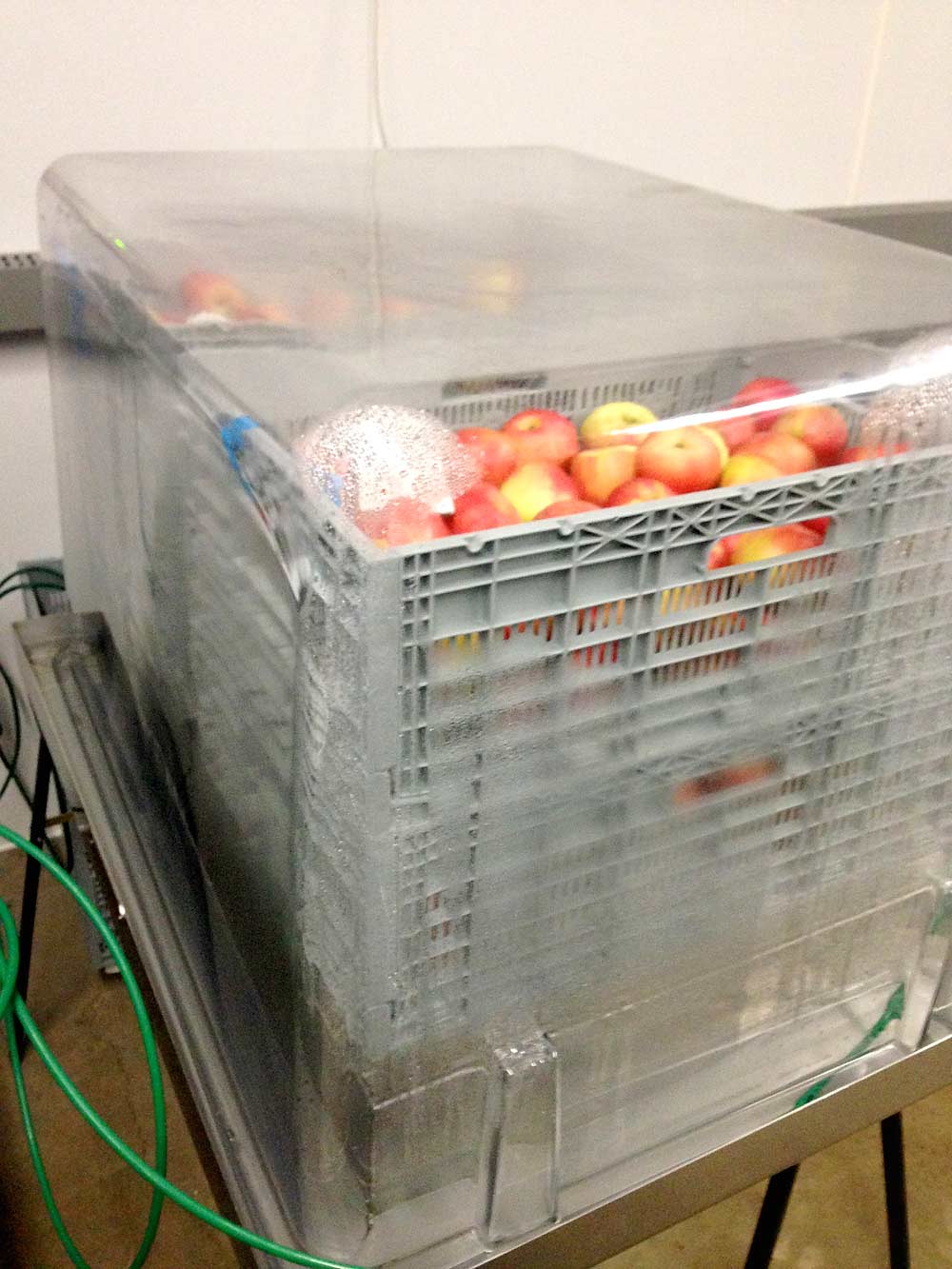
Apples sit in a SafePod in a storeroom in Kent, United Kingdom. The SafePod monitors the fruit’s respiration to assess how it is tolerating low-oxygen storage in order to help warehouses optimize storage conditions.(Courtesy Storage Control Systems, Inc.)
How are your apples doing in storage? Have you asked them?
It’s not as far-fetched as it sounds.
Like a canary in a coal mine, the latest monitoring technology offers warehouse managers the ability to assess how a small subset of fruit will handle low oxygen stress before pulling down the entire room.
Like other dynamic controlled atmosphere technology, this real-time feedback aims to optimize storage conditions for every variety, every orchard and every season, but with the safety of a test run.
Controlled atmosphere storage is a careful balance: Lower oxygen levels protect fruit quality and prevent senescence disorders, but going too low risks causing low-oxygen injuries.
Damage occurs after apples, suffocating in ultra-low oxygen levels, switch to anaerobic respiration. A new device, known as SafePod, tracks fruit’s oxygen consumption and carbon dioxide production to detect that threshold.
That allows warehouse managers to set room oxygen levels close to, but safely above, the anaerobic threshold, said Jennifer DeEll, a postharvest researcher for the Ontario Ministry of Agriculture, Food and Rural Affairs.
“It’s a better way to balance (controlled atmosphere storage) to see what the fruit is saying — if it’s happy or not — rather than us just saying use 2 percent oxygen,” DeEll said. “It’s literally a safer way to use a lower oxygen.”
The patented SafePod, developed by Michigan-based Storage Control Systems Inc., functions as a test chamber within a storage room.
It can be opened to share atmosphere with the larger room or closed down so that progressively lower oxygen levels can be tested on a small sample of fruit, not the entire room.
The goal is to enable storage operators to do dynamic atmosphere control, said Jim Schaefer, president of Storage Control Systems.
The chamber evolved from the company’s existing work on oxygen and carbon dioxide sensors. When carbon dioxide is rising relative to the oxygen consumption, it’s a signal that the fruit is suffocating. The equation is called the respiration quotient.
“We said, let’s take a lab cabinet, put a valve on it that can share or isolate (from the larger room), put in the respiration quotient system and let the apple talk to us,” Schaefer said. “The nice thing is we only stress out four bushels of fruit, the rest of the room is sitting there safe while we play with four bushels to get an indication of where we should bring the room down.”
On the market

Honeycrisp apples are subjected to ultra-low oxygen storage in a SafePod as part of an experiment to determine their ideal storage environment at the Ontario Ministry of Agriculture, Food and Rural Affairs. (Courtesy Jennifer DeEll)
Storage Control Systems already has offered the device to warehouses under lease agreements while the technology was fine-tuned, but the final model should be available for lease or purchase this fall, Schaefer said.
He declined to give Good Fruit Grower the price. A variant known as the LabPod is aimed at laboratory research, which lacks the SafePod’s ability to open a valve and meld its atmosphere with the larger room.
Stemilt Growers is testing the technology for the second year, said Glade Brosi, who manages research and development for the Wenatchee, Washington-based company. It’s beneficial to be able to test lower oxygen levels in the chamber first, he said, and get feedback from the fruit to make adjustments through the season.
“SafePod is appropriately named because you are not doing it to three-quarters of a million dollars’ worth of fruit in the room,” Brosi said.
He spent the first year familiarizing himself with the system and, after this season, expects to have data on SafePod’s performance. It’s part of a broader effort — including tests to look for disorder biomarkers in the fruit — to tailor storage conditions to best meet the needs of the apples.
“Instead of having standard treatments, you are looking for biological feedback,” Brosi said. “Every year seems to be different in some very significant way. Since none of us know how that affects the fruit, we have to look for ways for it to tell us.”
While SafePod is the first commercial technology available in the U.S. and Canada to directly measure fruit respiration in storage, several alternatives for detecting low-oxygen stress in dynamic controlled atmosphere systems have been in use for years.
One strategy is to monitor how chlorophyll in the peel changes as a result of anaerobic respiration, through a process known as chlorophyll fluorescence. In the U.S., this technology is marketed under the name HarvestWatch.
Another strategy is to measure the fruit’s ethanol emissions, which are produced by fermentation under anaerobic respiration.
That’s being used to guide dynamic controlled atmosphere systems offered by Wageningen University and Research in the Netherlands and a few other European companies, said Ines Hanrahan, project manager for the Washington Tree Fruit Research Commission.
There’s been more emphasis on development of dynamic controlled atmosphere technology in Europe since DPA (diphenylamine) — used to prevent storage scald — was banned by the European Union, Hanrahan said. Ultra-low oxygen storage is particularly effective for varieties such as Granny Smith and Red Delicious that are susceptible to scald, she said.
The benefit of using SafePod over other technologies that track chlorophyll or ethanol is that those changes occur after anaerobic respiration begins.
“I would much rather measure the change in respiration than wait for the ethanol,” DeEll said. “Respiration is the true change.”
Ultra-low-oxygen storage should also benefit organic growers who can’t use DPA or Smartfresh (1-methylcyclopropene), DeEll said.
In tests using the SafePod to run ultra-low oxygen (0.6 percent) on Empire apples for eight months in storage, she found more firmness and lower rates of flesh and core browning than apples held in traditional CA (2.5 percent oxygen) or at a standard low oxygen level (1.5 percent).
Her research was supported by Growing Forward 2, a Canadian agricultural research initiative, the Ontario Apple Growers, and the Norfolk Fruit Growers’ Association. Storage Control Systems donated the SafePods for the research.
By testing a gradual step down of oxygen in the pod to discover where the anaerobic threshold occurs, say at 0.4 percent, managers can then decide to hold the fruit at 0.6 percent in the entire room, DeEll said. Or, managers can keep the SafePod closed off to run a season-long experiment at ultra-low oxygen levels if they don’t want to do it on a full room.
“Gala is a good example. That fruit will tolerate a lot lower oxygen than we’ve ever given it credit for. We’ve had it down to 0.4 percent and they’ve come out clean. That’s so low it scares you to say it, but now we can test it,” DeEll said.
This year, she has Honeycrisp and Ambrosia apples in another trial.
“It’s just been an exciting opportunity to evaluate the fruit themselves to see what they can tolerate in terms of the atmosphere they are stored in,” DeEll said. “All together, we are looking more to the fruit now to see what they can tell us.”
And Schaefer hopes that the technology will allow apples to share other useful information as well.
“It tells us the low-oxygen limit — this is as low as I can go or I’m going to suffocate — but it also gives a true respiration value,” Schaefer said. “You could have six rooms of Galas and six different respiration values. Is the CA making their heart pump fast? That could be an indicator of what rooms to market first.” •
– by Kate Prengaman






Leave A Comment